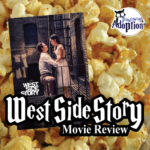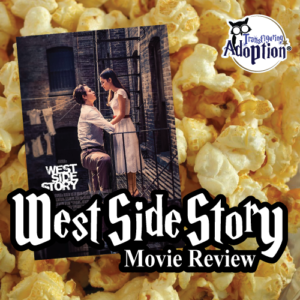
West Side Story (2021) – Movie Review
Review
West Side Story (2021) – Comprehensive Review
Transfiguring Adoption’s Overview:
West Side Story (2021) is a telling of Shakespeare’s Romeo and Juliet in New York City in 1957 much like the original musical it is based upon. There are some differences but much of the basic plot is the same as the 1961 film. However, this version does elaborate more on the racial disparity between the Sharks and Jets and also shows more how the local police treat the locals differently. There is also more mature content on screen compared to the older musical from 1961 so there is a more intense tone to the movie overall. Caregivers should be advised that this is not a film for younger children. Musicals can be written for various age groups so this needs to be kept in mind before hitting your local theater. This movie is also 2 ½ hours long so realistically your younger audience will lose interest pretty quickly in the plot.
The target audience appears to be children age 13 and up. It also appears this movie would be best for most families with a love for musicals.
** Spoilers Could Be Ahead **
How Is This Relevant To Adoption & Foster Care?
The youth involved all appear or are hinted to be lacking in adult support and for this reason youth with similar losses may relate to characters in this film. However, this is not a child-friendly movie. Like many musicals this is a very long movie with lots of complex plots that are not suitable for younger audiences. However, caregivers of teens who love emotional musicals will love the new cast and the fresher take on issues that still pervade our current social discussions about racial inequality, what defines family, and why youth need caring adults.
Discussion Points:
- Racial Inequality
This should not shock anyone who has actually seen the 1961 film of the hit Broadway Play, but this version of the film looks even closely at how racial inequality affects youth in the wider community. While we would hope that since 1957 there has been greater strides in equality for all there are still some common concepts that are still relatable today. Lieutenant Schrank embodies this the most in how he speaks to and of the Sharks (which are all Latino young men with roots from Puerto Rico). This is especially telling in the racially charged discussion he has with the Jets about how the ethnic group is moving into the neighborhood. For social change to happen we need to be open and honest about the issues that persist today to both help youth in positions of privilege ally themselves with members of the community combat racism and prejudice and also to learn how to better listen to the POC community about what good allyship looks like for them.
- Defining Family
The draw of the gangs is made clear upon our learning that Riff, Tony, and other characters who make up the Jets or Sharks are parentless. To gain support and a sense of belonging are very important needs for people of any age but especially young people. While it is great for youth people to gather and support one another if there isn’t the involvement of safe adult relationships these groups can make rash and unsafe decisions that can lead them and others into harm’s way. This is why connection with safe relationships like Tony and Valentina’s is crucial for adolescent development.
- Youth Need Adult Supports
While it is implied that Bernardo, Anita, and Tony are older and probably in their upper 20s or early 30s, it is clear that they have largely raised themselves and perhaps are not the best examples of wisdom for the younger Sharks and Jets. There is a lot of anger and frustration that has been left unresolved and certainly contributes to how they and the other members of the gangs respond to stress. Much like the Jets and Sharks, young people are more likely to feed off one another and make poor decisions without a caring adult invested in their future and well being. Tony was clearly on a very destructive path prior to spending time in jail and then being released to Valentina’s supervision. It is clear how her influence has helped him process the pain of the past and try to make better decisions for his future. However, once he tries to involve himself with Riff and the other Jets he is often dragged into self-destructive behaviors. The same scenarios play out today in the lives of young people and the best intervention for our youth is having more adults like Valentina who care deeply for youth and wish to invest in them and speak to them in ways youth can understand with compassion and care.
Cautionary Points:
- Violence
This film features violence inline with that of a film taking place in 1957. There are gun fights, knife fights, fist fights, and fights with youth using weapons such as rocks, bricks, pipes, and chains. Characters are killed and bloodied after such fights. There is also a scene where a character has a nail driven into their ear during a fight. While this film may not be as graphic as others it’s still important to remember that youth who have endured trauma often have overused stress-activation pathways to the limbic system and this can set off “fight or flight” responses even in response to positive excitement. For this reason caregivers need to keep an eye out for youth who may be triggered by the excitement of fight scenes in addition to trauma triggering from previous experiences.
- Death of Characters
During the course of the film Riff and Bernardo are both stabbed and die from the resulting injuries. There is a longer scene where Anita must identify Bernardo’s body and is grieving heavily. Tony is also shot and killed at the end of the film with his lifeless body carried away. While these characters are all fictional youth can be triggered by watching the death of a character and respond to unresolved grief from previous losses so caregivers should be aware to watch for such a response from their youth. - Gang Activity
The movie centers around two rival gangs fighting over territory so there are related behaviors such as vandalism, violence, going to jail, attacking women, stealing, smoking cigarettes and marijuana, minors drinking beer, and promiscuity. Though the film does show that there are permanent consequences to such activity in character deaths and injury this may be triggering for youth who idolize gang involvement.
- Police Brutality/Racism
Throughout the film it is clear that Officer Kripke and Lieutenant Schrank show obvious favoritism towards the white Jets over the Latino Sharks. Lieutenant Schrank makes a point to slap Bernardo in front of the two gangs and egg him on while he relaxes when alone with the Jets and seems to encourage their vitriol towards the Sharks. Bernardo observes directly when asked why his community doesn’t call the police for help: “When you show up you arrest us.” While this is a fictitious piece and doesn’t dig very deep into this plot point this may be triggering for youth who are not trusting of police officers due to racial profiling and other issues that persist currently.
- Racially Charged/Foul Language
Throughout the film the ethnically derogatory term “Spic” is used frequently and often. The term “Pollack” is also used for the white characters a couple of times but the use of the term towards the Latino communities are more pervasive throughout the film. There is also discussion from Lieutenant Schrank about how members of the Puerto Rican community are taking over the neighborhood by moving in and having babies. Jet characters also tell Anita: “Go back to where you came from” and “She’s too dark to pass.” Such discussion can be triggering for youth who have experienced racist language being used towards them. One character also says “goddammit” a few times and there are insults said such as “go suck a pickle” and “suck on your sister’s titty you guinea hyena” that can also be considered explicit.
- Implied Sexual Content
At the start of the film Riff comes out from a construction vehicle with Graziella and it’s clear they have been intimate. Anita and Bernardo also come home from the dance kissing sensually as they head to the bedroom to likely have intimacy. Throughout the movie Tony and Maria kiss very sensually and end up making out on her bed after Tony kills Bernardo. They are roused from Maria’s bed unclothed and have to dress before leaving the room so they had sex for sure. No characters are shown fully unclothed or in the action of having sex while on screen.
About the Reviewer: Rachael B. Rathe
Rachael B. Rathe is an East Tennessee native with a Bachelor of Arts Degree in Psychology with a Minor in Child & Family Studies from The University of Tennessee Knoxville. She has worked in mental health since 2013 and in foster care/adoptions for a private provider agency since 2014. Rachael was inspired to work in the field after working with children and teens on a volunteer basis 2008 – 2013. Rachael’s ideal self-care day involves snuggling on a couch with her kitties (Tabitha, Fergus, and Rufus) while enjoying a good movie or book. She also enjoys galavanting around conventions concerning all things nerd and geekery.
